Introduction
We have heard enough that technology is evolving and with that cross browser compatibility testing is gaining traction. Although the users are becoming more tech savvy and informed, they are still reluctant to try out different browsers. Businesses have different types of users, which means not everyone will use one kind of browser. Even though there is a high demand for Chrome, Mozilla Firefox or Safari, there still are users who rely on older versions of browsers other than these. Because of which businesses end up accommodating outdated technology that leads to a slower system and dissatisfied customers. Cross browser compatibility testing ensures that customers don’t become bait to the consequences of outdated systems. And hence the need for a thorough cross browser compatibility testing is vital for businesses to resolve Cross Browser Compatibility issues and ensure the best user experience.
What is cross browser compatibility testing?
Every website communicates in a unique way with every browser; even each browser renders the website in a distinctive way. This often causes cross browser compatibility issues at different stages. The overall visual appearance of the website isn’t only dependent on the front end development but also on the type of browser used to access the website. To avoid cross browser differences, businesses should practice cross browser compatibility testing to guarantee consistent delivery of quality user experience. Cross browser compatibility testing is a non-functional testing that enables businesses to offer best features of the website on different OS-Device-browser combinations.
Why is Cross browser compatibility important?
The key function of cross browser testing is to make your website workable across different browsers and devices. The older versions of the browser pose errors and problems in making the best out of the website’s features. With the help of Cross Browser Compatibility Testing, you can test the capability and limitations of the devices. Compatibility can be tested in case of older browsers that are not updated by users, for the browsers that do not support modern JS or CSS features, compatibility of less common browsers, a range of device platforms, and devices with assistive technology features, etc.
Which browsers should you choose for cross browser testing?
We already know that all browsers are different and it is practically not feasible to test every browser-device combination. So, it becomes important to choose which ones are critical to your business where your web application can be tested for compatibility issues.
According to Kinsta’s 2021 data, Google Chrome has 64.08% user base, highest Global Desktop browser market share followed by Safari (8.87%), Mozilla Firefox (7.69%), Microsoft Edge (5.83%), Internet Explorer (2.15%), and so on. Clearly, Google Chrome has captured the maximum market but that does not mean that other browsers are not meant for you. Safari, Edge, Firefox, IE have a great demand in specific devices and different regions of the world .For example, Opera is a trending browser in Africa and UC Browser in Asia. So, no browser can be ignored and parts of it should be tested for compatibility based on user traffic. Below is the data from Statista showing market share of different browsers over the years till January 2021.
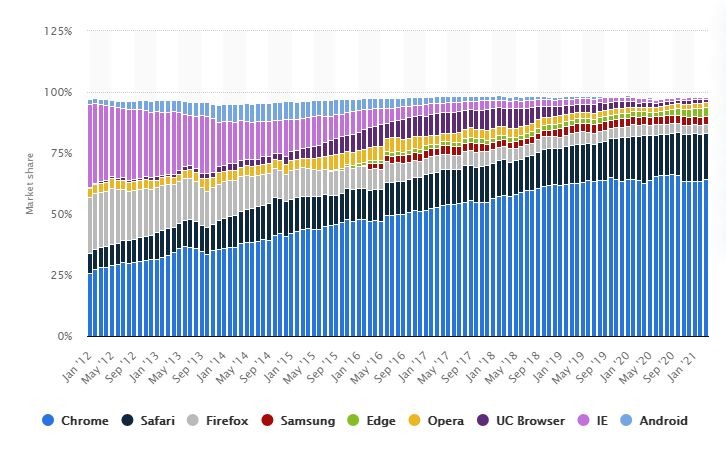
Source: Statista
Is the market share enough to decide the browser you should choose to test?
Well, analysis of the volume of users and market share of various popular browsers and their versions based on geography and different platforms is critical to business for strategizing cross browser testing of their application. But, it is not the only reason to make a decision. Other factors:
Target Market: A business should understand their target market and what browsers most of its users are choosing. It is the first factor a business considers for compatibility testing.
Older Versions: Many users globally use older versions of Windows OS and still choose Internet Explorer. In this case, testing for Internet Explorer Compatibility is important.
Business Indicators and Value Addition: We know Safari is the second most used web browser in the world. So it is clear that the users who use Safari use Apple products which are quite expensive to many. This means Safari represents that section of users which has high purchasing capacity. It acts as a business indicator and makes Safari an important browser to be tested for compatibility despite their lower global user base. Luxury brands and marketers should ensure their website runs smoothly on Safari so they don’t lose any customers because of poor website usability or compatibility issues.
Geographical orientation: Certain browsers have a high user base concentrated on a particular geography or location. There are specific market segments focused on the US, ASIA, UK , etc. For example, Google Chrome, which is the most popular browser than UC Browser, is mostly used in Asian regions, Opera in Africa, and so on. So, businesses should understand the trends and their target market segment based on Geography so that no important browser is deprived to perform the compatibility testing.
Importance of Testing Old Browser Versions
The latest Google Chrome version is Chrome 91, but there are chances that users would still be using its older versions like Chrome 60, 61, 74. But, how would it impact your business, is a question we all ask. The continuation of using the old browsers will directly impact the functioning of your website. The website will stop running or might crash altogether. Businesses might lose customer traffic and ultimately impact the revenue figures. So, it is vital for businesses to be testing on old browsers when automating the Cross Browser Testing. We’ve listed down a few more aspects to think about to encourage testing of old browsers when performing cross browser testing – –
1. To provide seamless User Experience: Ensure that the User Interface looks the same in all browsers/ browser versions to maintain the HTML and CSS compatibility. The user experience is one of the key reasons that motivate the customer to stay with your business. Why not adhere to this simple practice if it helps in customer retention?
2. To Retain Customers: Not all users keep their browsers up-to-date. Frequent browser version releases need to be checked to ensure compatibility with every browser version, or it might just disrupt the functioning of the business website and loss of customer traffic.
3. Company Security: Sometimes, the company restricts updating the website frequently because of security reasons and prefers sticking to the older versions.
4. Impact on Revenue: Businesses exist because customers and customers are their revenue sources. Most customers engage in business through a website. If the businesses fail to provide the best website experience to the customers, then, no matter how great is the quality of your product/ service is, the unhappy customer ultimately switches to another business, resulting in the business losing money. So, whatever you are selling, keep in that your customer can visit your website from any browser version, so testing even the older browser versions becomes essential.
RELEVANCE OF BROWSERS OTHER THAN CHROME
Browsers like IE, Safari, Edge are very significant to businesses despite their low global usage. Safari is used by apple users representing the people with high purchasing power; hence, it is relevant to luxury brands to test website compatibility on Safari. Microsoft’s IE and Edge are popular among companies using Microsoft Office tools more, so they should test compatibility even on these two browsers.
The chart below ( By Statcounter ) shows the latest trends of browser market shares in the past year. It is clear from the chart that apart from Chrome and Safari, other trending browsers are Firefox followed by Samsung Internet that has shown an increasing trend in the past few months. Also, Edge, Opera, UC Browser, IE, and Edge legacy are a few other browsers preferred worldwide.
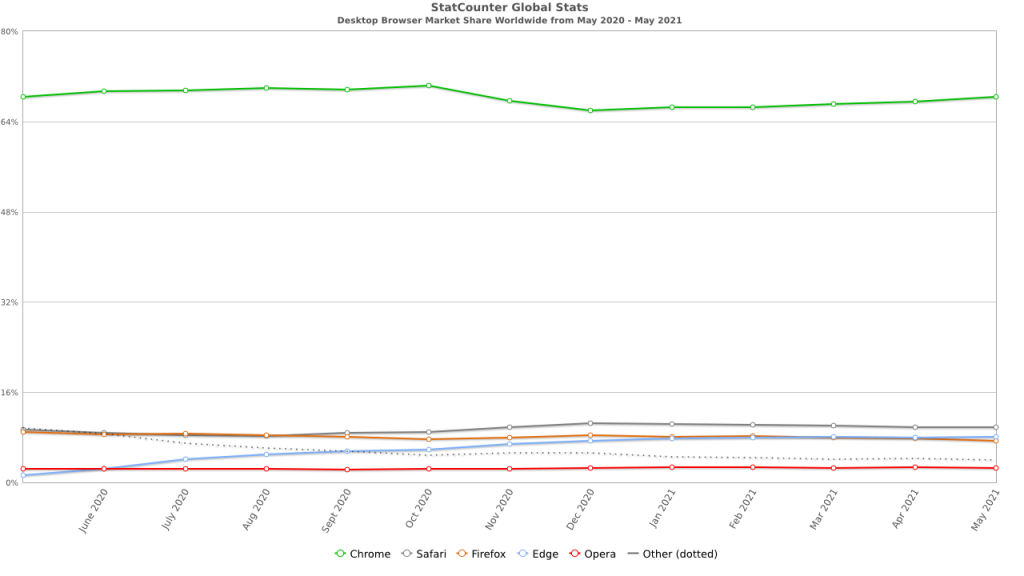
CHOOSING BROWSERS BASED ON CONTINENTS
By now, we know that Chrome is the most popular Web Browser among most users. Let us figure out which one is the second most famous browser in the world based on continents.
ASIA:
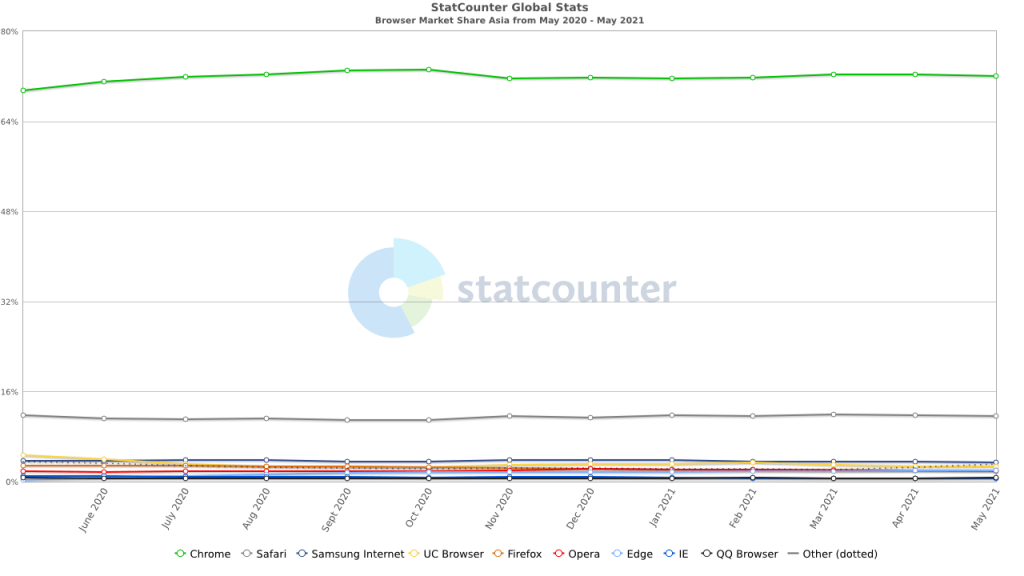
After Google Chrome and Safari, Samsung Internet is the most trending browser in Asia in 2021, followed by UC Browser, Firefox, Opera, Edge, IE, etc. So, the UC browser is among the top three contenders in Asian Market.
Top 3: Chrome, Safari, and Samsung Internet.
Africa
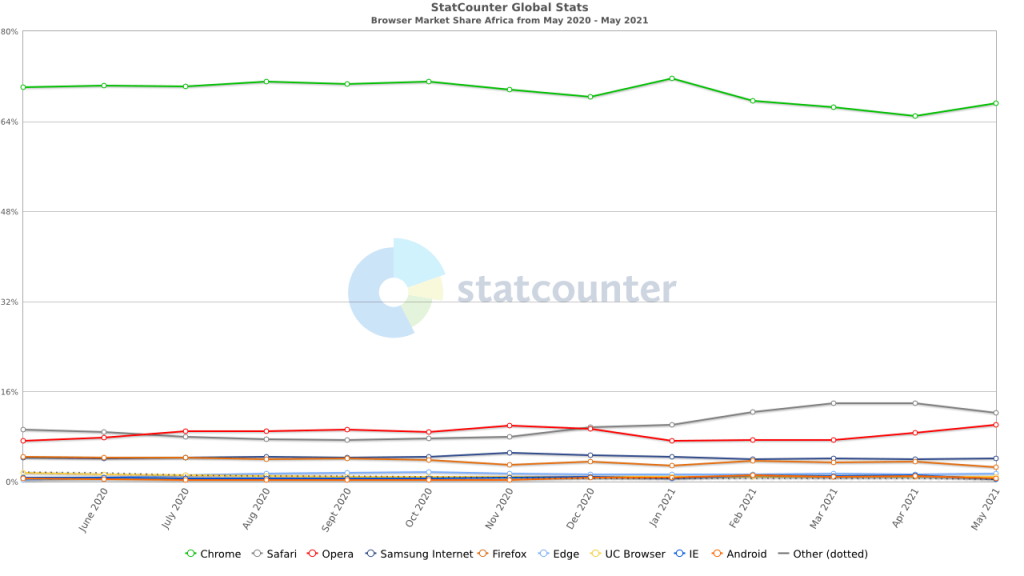
The chart above shows the trends from June 2021 to June 2021 in the African Continent. After Google Chrome, Safari and Opera are struggling to be the second most preferred browser followed by Samsung Internet, Firefox, Edge, UC Browser, IE, Android, etc.
Download a free Poster that gives a pictorial representation of the Top three Browsers preferred across continents.
Top 3: Chrome, Safari, Opera
EUROPE
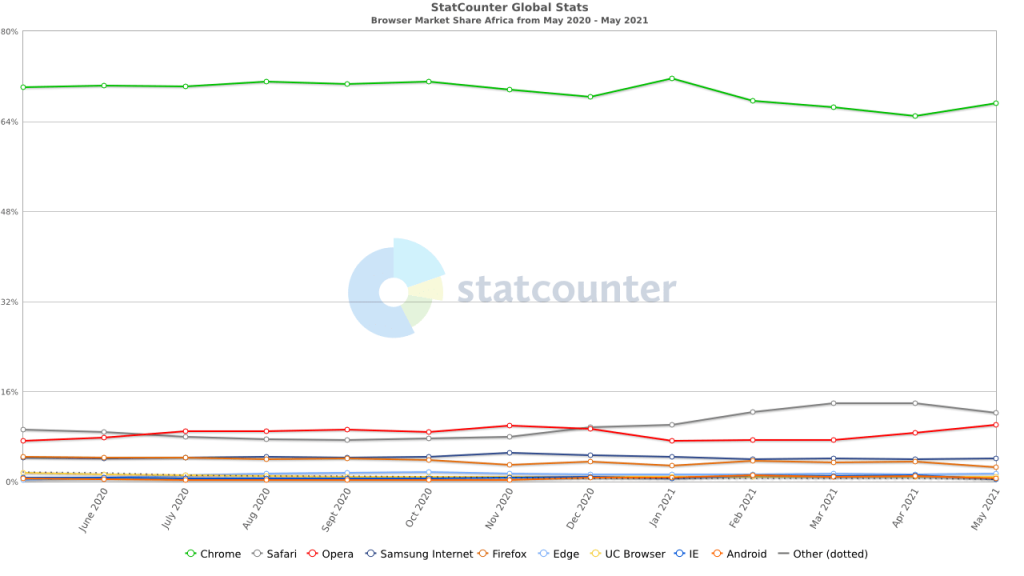
Even in Europe, Google Chrome remains on the top. The above yearly figures show that there is tough competition among all other browsers. Safari and Opera are among the top contenders of the second position in Europe, followed by the rest of the browsers.
Top 3: Chrome, Safari, Opera
North America
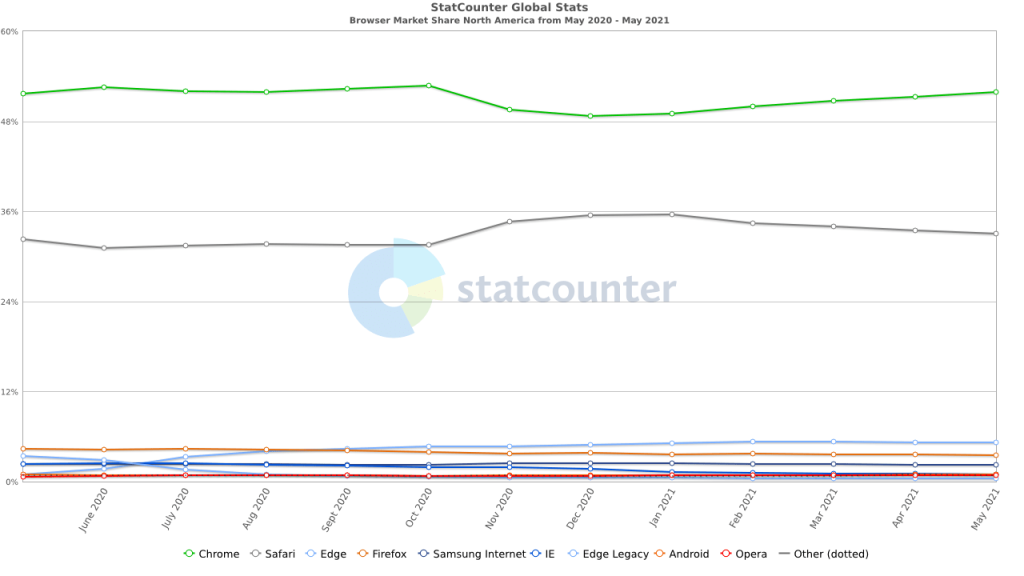
In North America, after Google Chrome, there is a tight competition for second place among browsers like Safari, Edge, Firefox, Samsung Internet, IE, Edge, etc.
Top 3: Chrome, Safari, Edge
South America
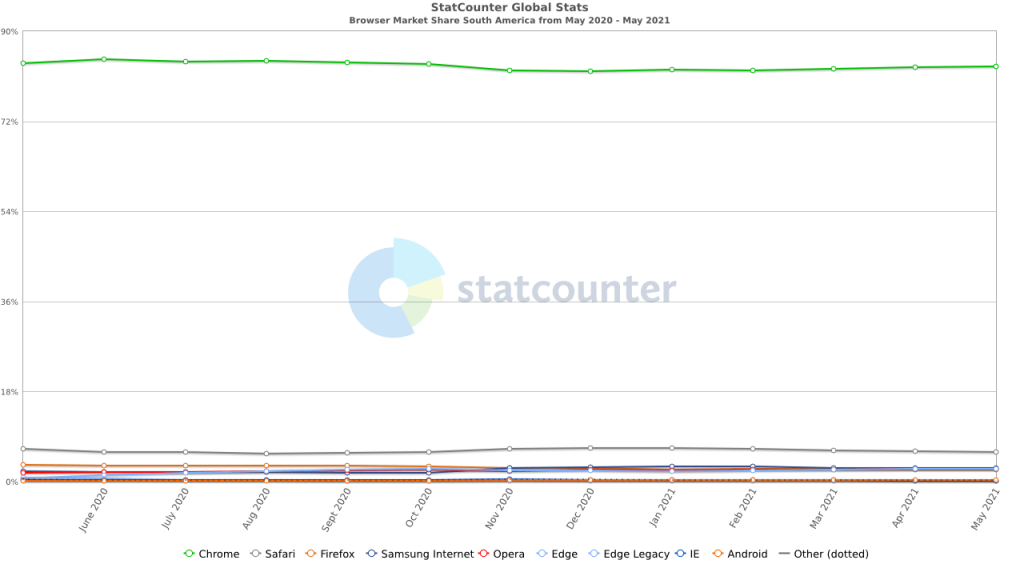
Google Chrome is unequivocally the top most popular browser even in South America. Contenders for second place are Safari and Firefox followed by Samsung Internet, Opera, Edge, etc.
TOP 3: Chrome, Safari, Firefox
OCEANIA/ AUSTRALIA
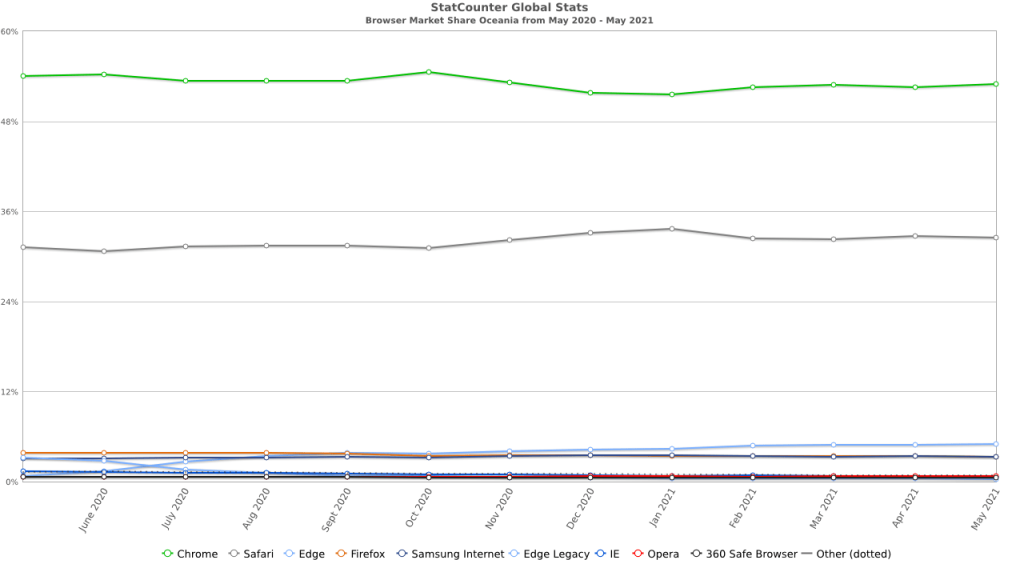
In the Oceania region, Chrome is on the top. Safari outruns other browsers like Edge and Firefox for the number two spot.
Top 3: Chrome, Safari, Edge
Antarctica
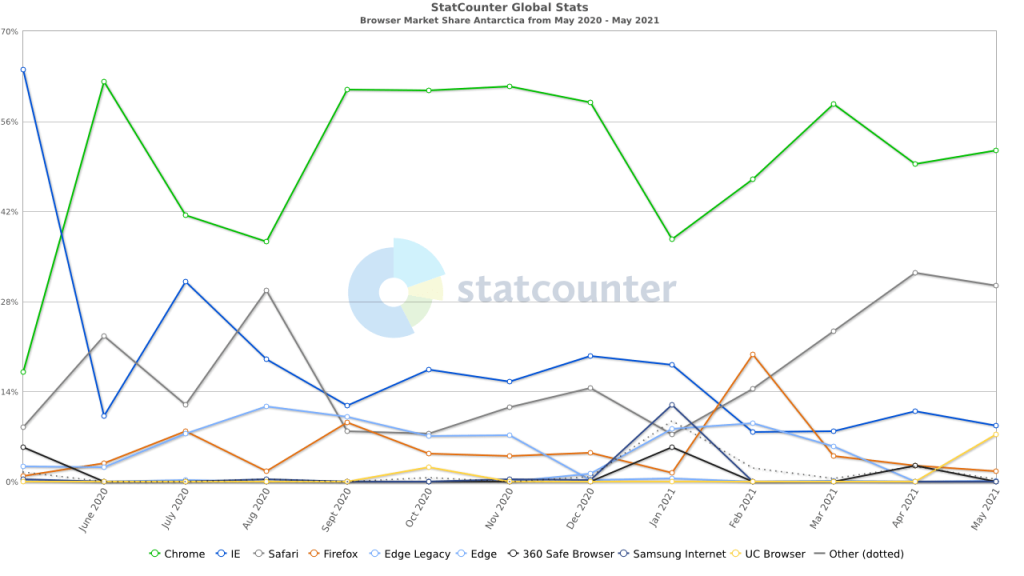
Most businesses ignore Antarctica thinking about its low population of approximately 5000 people residing near science stations. It is interesting to know, even in such extreme situations and with the widest reach of the internet, which browser Antarcticans prefer when they browse the internet in such conditions. The continent matters because it has shown mixed trends related to browser preferences that make it necessary for businesses to keep an eye on them. In Antarctica, there has been a consistent struggle between the browsers to be on top. Google Chrome still manages to be the most preferred browser, followed by Internet Explorer, Safari, Firefox, etc.
Top 3: Chrome, IE, Safari.
CHOOSING BROWSERS BASED ON DIFFERENT DEVICES
Targeting browsers based on different devices they are used on is critical information for the business decisions regarding compatibility testing. Let’s have a look:
Desktop:
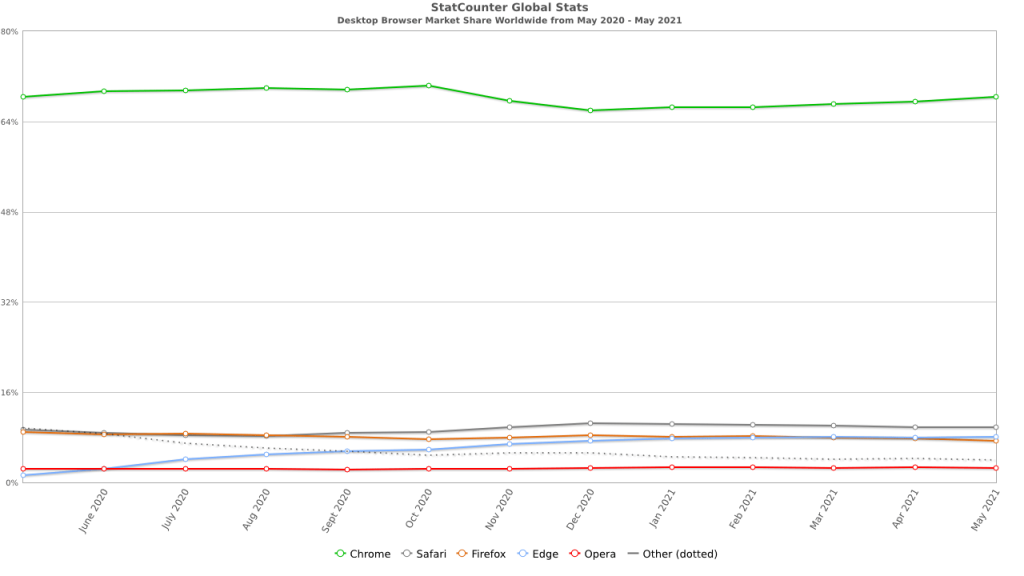
Google Chrome dominates the global desktop market in 2020-2021. Safari is the second most popular with just a few points higher than Firefox, Edge, and Opera, competing for the third position.
Mobile:
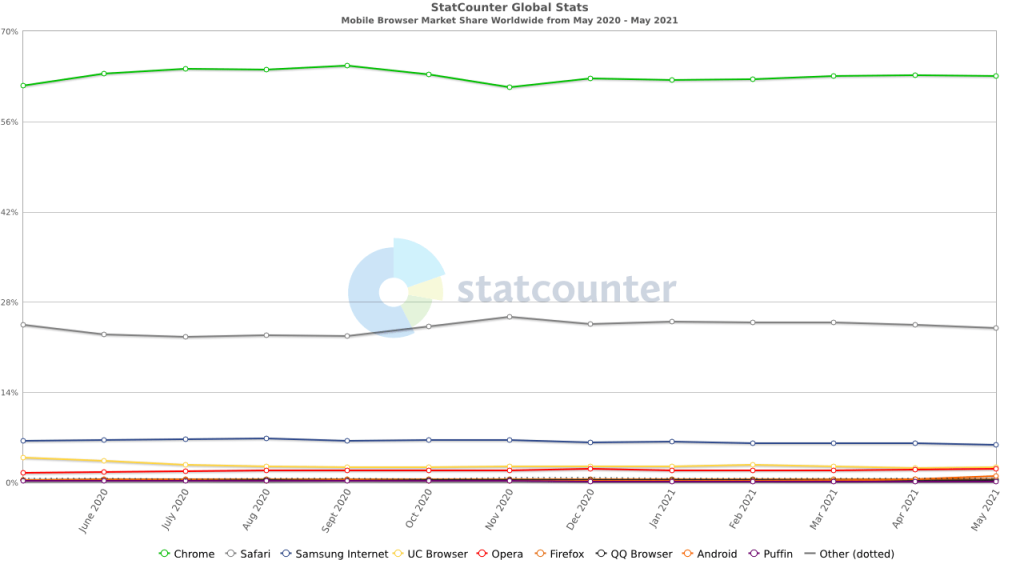
In the global mobile market 2020-2021, Google Chrome again stands tall. Safari has saved its second position, followed by Samsung Internet maintaining the third spot, unexpectedly.
Tablet:
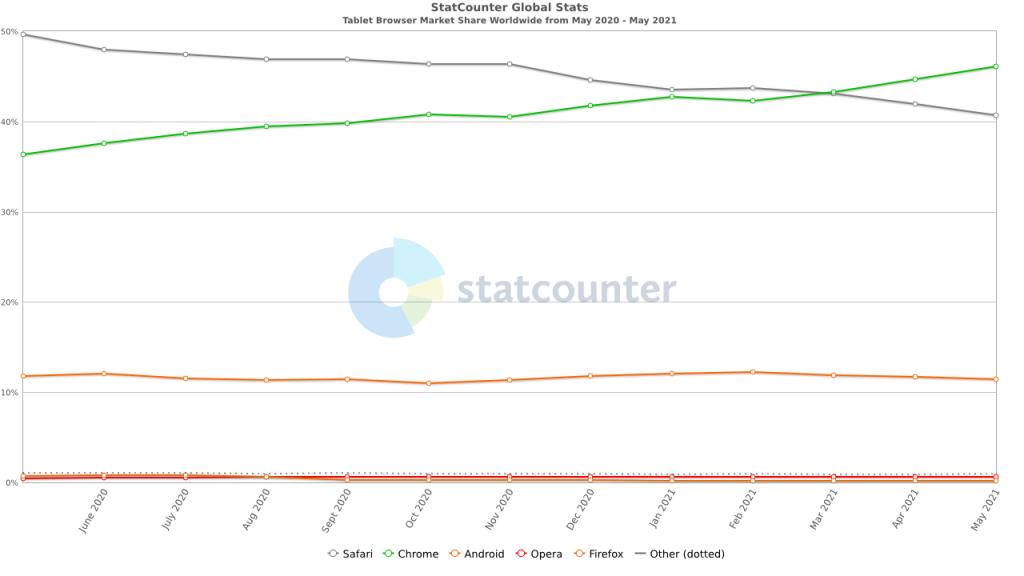
Safari beats Chrome! It is the most unusual trend seen so far. There is a top-level competition between Chrome and Safari for the first spot, but Safari wins this time. The most probable reason for Safari being on top is the dominance of iPads from Apple. The second and third spot is owned by Android and Opera in the Tablet space.
FEASIBILITY OF TESTING SO MANY BROWSERS
How to solve Cross browser Compatibility issues for so many browsers is a question that comes to every mind. Running Cross browser testing on a mix of browsers running on multiple OS and computer systems can be a nightmare for many enterprises. What to do to overcome this?
Once the right choice of browsers is made based on the data provided above, businesses can start performing cross browser compatibility testing either manually or using automation tools like Selenium, which is the most preferred tool in the automation testing space. Based on the budget and cost limitations, organizations can also perform cross browser testing on a cloud-based platform like pCloudy instead of maintaining an in-house real browser lab. By keeping in mind the type of audience, browser matrix, right automation tool, and testing on real devices, one can successfully implement cross browser compatibility testing.
Conclusion
What browsers to test is not a research-based decision; it depends on which browsers your target market prefers. It is the responsibility of the businesses to provide hassle-free access to the website features to the users. For an effective cross browser compatibility testing strategy, an enterprise should keep in mind the type of audience, its browser matrix, automation tool selection, and decisions regarding testing on real browsers. You just need to find the right balance- choosing minimum browsers-OS combinations to ensure maximum target audience coverage and user experience.





 August 02, 2023
August 02, 2023

 June 09, 2023
June 09, 2023






